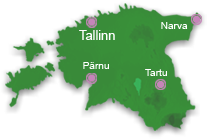| Companies | Tourist Attractions & Sightseeing | Map Search |
CHEF TALKS: AN INTERVIEW WITH CHEF RANNO PAUKSON FROM Ö10.April 2018
Silverspoon 2017 winner: Best Fine Dining
”Ö” used to be the last letter in the Estonian alphabet until the early 19th century when Otto Wilhelm Masing changed it to ”Õ” because of an alleged confusion with the pronunciation. Be that as it may, or may not be, but today ”Ö” stands for best Fine dining in Estonia.
Ranno Paukson, height at the withers about the same as me, making us about 175cm short, wears a ”Kopli” blouse, a couple of piercings, peaked cap and a beard under his chin. The walking image of a serious cuisnier nowadays. Chef Paukson shares the ownership of Ö with chef Martin Meikas.
It goes without saying, I like him immediately. I barely have to present my first questions when Ranno starts machine-gunning about the subject, making the interviewer’s job easy. No need to deploy the thumbscrew in order to get the answers this time!
Ranno has been lifting irons for fifteen years in different kitchens, which, despite his not-so-old age, makes him already part of the Old Guard manning the posts in Estonia’s culinary watch. So what’s going on in the food scene?
Culinary education in Estonia.
Estonia, especially Tallinn, is suffering from the same shortage as Helsinki (and most of Finland for that matter), a shortage of qualified cooks. Some years ago restaurant Umami’s Kristjan Peäske, whom I was privileged to meet at a wine symposium in Tampere, Finland, a few years ago (So hi Kristjan if you’re reading this!), suggested that the culinary school would be partially changed to include an apprentice program. The idea was to make employment more efficient and guarantee good training. Unfortunately this went somewhat unheeded on the policy-making level.
“The young cooks don’t learn any leadership skills at school. I’ve been cooking for fifteen years and I want to be a better boss to my chefs than what I’ve had in the past,” explains chef Paukson.
It is somewhat true that schooling divides the trade. While trade school level is meant to produce professionals of the field, the schooling lacks any leadership education. This adds up with the ‘Ramsayian’ image of a chef throwing plates and going apeshit in the kitchen – simply because it’s the only way they know how to lead. The upper-trade school, on the other hand, teaches leadership but the graduates lack practical know-how what the everyday knife-work, required from a chef de cuisine, still demands.
Where is Estonian cuisine headed?
Looking at the culinary scene’s movement in Estonia, chef Paukson offers an interesting aspect. He worked abroad in Austria, Finland, Sweden and Norway. In Norway he worked in the famous Maaemo at the time it received it’s second Michelin Star. Ranno employs this experience when he looks at the Estonia’s culinary scene: “What I see is this new generation arising which has grown along the past 25-years in denial of the Soviet era. These young chefs are now looking to re-establish the Estonian cuisine.” Perhaps unconsciously having the “trauma” set aside, many young chefs have found the own backyard in Estonia full of usable ingredients after their quests abroad.
“I noticed in Kiev that the movement concerns all the Baltic countries. Estonia does not have almost anything in common with Ukraine. But what is evident is that we all have shared the same ingredients but with different names for a long time.” He refers to this style as the “post-soviet cuisine”.
Ranno concludes: “Food connects people.” Under the same umbrella dumpling became a dumpling even if it had a different name.
More cooperation between restaurants
“Cooperation, among the restaurants, is an essential key to success”, says Paukson. The tourists cannot be the only source of income for the high-end establishments. “Tallinn is still a small place when it comes to tourism,” Ranno points out and adds: “A hundred new restaurants were opened last year.” Hypothetically thinking, even if the planes and ferries brought enough tourists to fill those tables, the infrastructure would not keep up. The restaurants simply need to remain attractive also to Estonians.
A fine example of cooperation is found from Kuressaare, at the Saaremaa island. A local community of restaurants was formed. They nowadays organize a street food festival, where tables are set together outside and the people sit at common tables, while the restaurants provide the meals. Very Mediterranean!
Fine dining & future trends
What about Ö’s position in Estonia’s culinary culture? Ranno refers to his experience dining at Noma – one of the world’s best restaurants in Denmark: “Everything in the tasting menu was not definitely good.” Noma holds sort of an institutional status among the restaurants in the world. It is responsible of innovating new trends, and then inevitably bound to be copied. I ask how chef Paukson sees Ö’s role in Estonia as an institution. “In my opinion there is a certain line how far you can go. I wouldn’t for example feed my guests with dirt and try to claim it is high cuisine”, he says promptly. “But I hope we can be an example to others by creating something new. After all this is what I do, and have always been doing.”While Noma lead the culinary charge for some years with the New Nordic trend, it has now become, more or less, a passed fancy. This is perhaps why Noma went through its remake and opening doors again with a slightly different concept. Paukson feels there is a vacuum able to fit a new trend. “I do not see a single reason why the new ‘post-soviet’ style, with its wide influence in the Baltic, could not become the next big thing.”
We shake hands. It is the end of this interview, which gave a lot to think about. Ranno is hurrying with his jacket. He’s already late from his next appointment. Leslie da Bass is rehearsing in the evening and Ranno is playing the drums.
Chef Talks is a new Silverspoon Awards story series dedicated to introducing the hearts of every restaurants kitchen, the Chef’s and giving the readers a chance to learn more about the Top Chefs in Estonia.
The author, Juho Kääriäinen: a yesterday’s chef and a today’s hedonist, who consumes gastronomy in all it’s forms. He likes his steak “as kitchen sees fit”, and prefers Global-knives instead of MACs.” |




)
